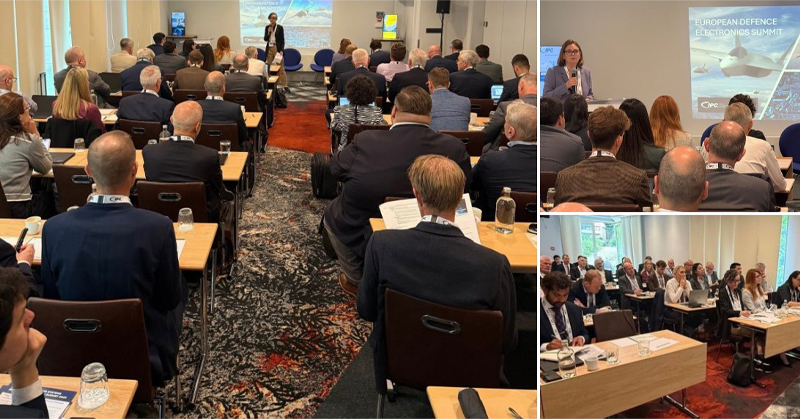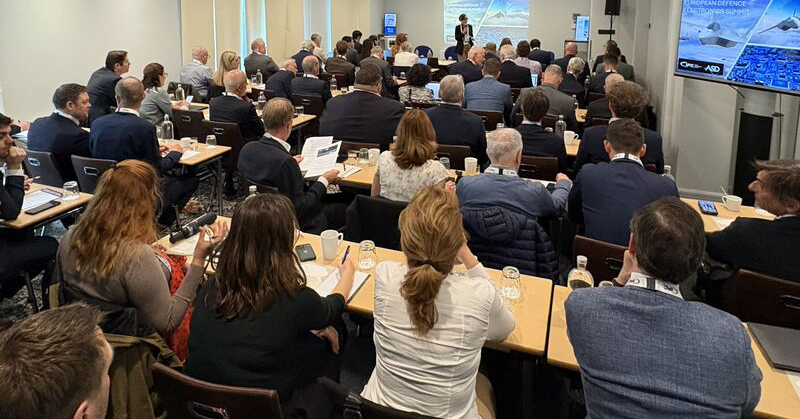 |
Dear [Colleague]:
From global trade talks to defense funding and “nearshoring” trends, this week’s headlines again show how fast the landscape is shifting for electronics manufacturers.
On the trade front, U.S.-China negotiations achieved another fragile interim deal, with discussions centered on critical minerals, semiconductors, and tariff relief.
Here in Washington, a new defense spending bill proposes major investments in the industrial base, potentially opening new avenues for electronics manufacturing support.
In Europe, IPC and ASD convened a high-level summit to align industry and policymakers on building a stronger defense electronics ecosystem.
In Mexico, we continue to see a surge in investment and attention as a supply chain hub, while at the same time India and Vietnam are rolling out new policies to grow electronics production.
Keep reading for the five-minute rundown, and as always, let us know how we can support your interests.
Chris Mitchell
Vice President, Global Government Relations
The Headlines at a Glance:
TOP NEWS OF THE WEEK
- New U.S.–China Deal Maintains Tariffs, Eases Some Exports
QUOTE OF THE WEEK
- EMS Firms Need to Balance Global Efficiency with Regional Resilience
UNITED STATES
- FY26 Defense Bill May Be Positive for Electronics
- U.S. Tax and Spending Bill Faces Senate Showdown
- Op-Ed Urges Action to Strengthen U.S. Defense Supply Chain
EUROPE
- IPC and ASD Convene Summit on European Defense Electronics
MEXICO
- Report Highlights Mexico’s Growing Role in Post-Tariff Supply Chains
- Automotive Investments in Mexico Signal Opportunities for Electronics
ASIA
- India Looks to Deepen Electronics Manufacturing Footprint
- Vietnam and Japan Expand Cooperation on Supporting Industries
ENVIRONMENT AND SUSTAINABILITY
- U.S. DoD Seeking Information on Chemicals Used in Defense
- IPC Webinar Explores What’s Next for EU Sustainability Reporting
OTHER HEADLINES IN THE NEWS
- MSN | Defence Sector Under PM Narendra Modi: 'Import-Dependent To 12X Surge In Exports'
- UPI | Taiwan’s chip dominance becomes global security, economic flashpoint
- Newsweek | America's Auto Manufacturers Working to Future Proof Their Workforces
HELP US SPREAD THE WORD ON SOCIAL MEDIA
KEEP IN TOUCH WITH US
 |
New U.S.-China Deal Maintains Tariffs, Eases Some Exports: The Trump administration this week outlined a new trade framework with China, signaling a shift in tone while leaving many details still unresolved, reports The New York Times. While formal text and implementing measures have not yet been released, reports indicate the following high-level terms: a combined 55% tariff on Chinese imports, which include the existing tariffs, a 10% “reciprocal” tariff, and a 20% fentanyl-related tariff imposed under the International Emergency Economic Powers Act (IEEPA). This structure largely reflects the status quo as of 14 May for many electronics-related imports.
In return, China has reportedly agreed to resume exports of rare earth minerals, a key supply chain concern for electronics, clean energy, and defense sectors. The U.S. is also expected to ease certain export controls on advanced semiconductors, although timelines and enforcement mechanisms remain unclear.
IPC welcomes the progress but remains concerned about ongoing compliance burdens and policy uncertainties facing electronics manufacturers. IPC weighed in officially on the negative impacts of tariffs on our industry, and we will continue to call for a stable, strategic trade policy that strengthens America’s electronics supply chains. IPC Contact: Richard Cappetto
 |
 |
— Sanjay Huprikar, IPC’s Chief Global Officer, in a new IPC Blog post
 |
FY26 Defense Bill May Be Positive for Electronics: The U.S. House Appropriations Committee this week approved its FY26 defense spending bill, totaling $831.5 billion and placing heavy emphasis on strategic competition with China. The bill is specifically proposing $321 million for Defense Production Act (DPA) purchases, an encouraging topline, but with no specifics yet on how the funds will be allocated. The bill also includes $97.7 million for the Defense Credit Program to invest in the industrial base, a sign that Congress is eyeing continued support for U.S. manufacturing capabilities. These programs have previously supported reshoring efforts in printed circuit boards (PCBs) and advanced packaging, which are critical technologies that underpin defense readiness. IPC will be watching closely for additional details, and we’ll remain focused on ensuring that PCBs, advanced packaging, and other electronics technologies are part of the defense funding conversation. IPC Contact: Richard Cappetto
U.S. Tax and Spending Bill Faces Senate Showdown: The House-passed “One Big Beautiful Bill Act,” a legislative package of President Trump’s tax and spending priorities, faced turbulence in the Senate last week, as intra-party disagreements emerged. AP News reported that some Senate Republicans pushed for deeper federal spending cuts to address the deficit, while others wanted to alter business tax incentives, including provisions benefiting R&D and capital investment. Still others are pushing to preserve clean energy tax credits enacted under the Biden-era Inflation Reduction Act. IPC continues to monitor how the package could affect electronics manufacturers. IPC Contact: Richard Cappetto
Op-Ed Urges Action to Strengthen U.S. Defense Electronics Supply Chain: In a recent op-ed, U.S. Partnership for Assured Electronics (USPAE) Executive Director Jim Will called for urgent action to strengthen America’s “fragile” microelectronics supply chain. Will argued that the U.S. doesn’t suffer from a lack of innovation or investment, but rather from a lack of coordination, and that continued inaction threatens both national security and industrial resilience. The paper outlined five steps to build a stronger foundation: map at-risk components; fund domestic demonstrators; build the full supply chain beyond chips; enable scale through commercial viability; and hold integrators accountable. IPC encourages stakeholders across the industry to join the conversation on how to accelerate solutions. IPC Contact: Richard Cappetto
 |
IPC and ASD Convene Summit on European Defense Electronics: This week, IPC and the Aerospace, Security and Defense Industries Association of Europe (ASD) jointly hosted the first IPC-ASD Europe Defense Electronics Summit, bringing together 70 leaders from across the electronics manufacturing supply chain. Participants included OEMs, EMS providers, PCB and semiconductor manufacturers, and wire harness suppliers, alongside 10 senior policymakers, including representatives from the Cabinet of the Commissioner for Defense and Space and three European Commission directorates general. The discussion focused on the challenges facing Europe’s defense electronics base and the urgent need for a more resilient ecosystem. Industry leaders emphasized the strategic importance of electronics to Europe’s security goals and called for this to be reflected in future policy and investment decisions. Check out the recent IPC white paper on European defense electronics. IPC Contact: Alison James
 |
Report Highlights Mexico’s Growing Role in Post-Tariff Supply Chains: A new report from Bank of America finds that Mexico is emerging as a key beneficiary of shifting global supply chains in response to U.S. tariffs. An article from Investopedia says that while the goal of recent trade measures has been to boost U.S. domestic manufacturing, only 20% of analysts surveyed expect significant reshoring to the U.S. Instead, many firms are opting for nearshoring to Mexico, particularly in sectors like electronics, transportation, and labor-intensive manufacturing. Analysts point to Mexico’s geographic proximity, USMCA trade advantages, and expanding industrial base as key drivers. For the electronics industry, these trends underscore Mexico’s growing importance as a regional hub for production and supply chain realignment. IPC Contact: Lorena Villanueva
Automotive Investments in Mexico Signal Opportunities for Electronics: A wave of recent announcements from global automakers and suppliers is highlighting Mexico’s growing role in advanced manufacturing. According to Freightwaves, China’s TYW Manufacturing has launched a $50 million facility in Irapuato to produce electronic dashboards for Kia and Stellantis, creating 500 jobs and expanding the region’s footprint in auto electronics. Meanwhile, GPI News reported that Mazda, Honda, and Toyota are deepening their long-term presence in Guanajuato with investments tied to clean energy, electrification, and tech-driven production. In a separate development, China’s Wasion Group has inaugurated a $7.3 million plant in Irapuato focused on electrical components, according to Mexico’s Secretariat of Economy. Kia Motors also confirmed via Cluster Industrial that it will continue operations in Nuevo León and invest another $2 million this year to expand its technology training center. Finally, Nissan announced that it is consolidating production in Mexico rather than downsizing, moving pickup manufacturing from Argentina to Morelos and reaffirming its Aguascalientes plant as a key global site. For the electronics industry, these developments signal rising demand for components such as PCBs, sensors, power systems, and embedded software, particularly as vehicle platforms grow more electric and connected. IPC Contact: Lorena Villanueva
 |
India Looks to Deepen Electronics Manufacturing Footprint: India is aiming to expand its role in global electronics production, with new reports highlighting a push to attract investment and ease supply chain challenges. According to Business Standard, the Indian government is exploring ways to streamline tech import approvals and strengthen incentive schemes under its Production-Linked Incentive (PLI) program. These efforts follow recent concerns from electronics firms about approval delays affecting production timelines. As companies worldwide continue diversifying beyond China, India's steps to reinforce policy support and reduce red tape are being closely watched. For the electronics industry, these developments could influence regional sourcing strategies, investment decisions, and the pace of global supply chain reconfiguration. IPC Contact: Gaurab Majumdar
Vietnam and Japan Expand Cooperation on Supporting Industries: Vietnam and Japan are stepping up efforts to strengthen their mutually supporting industries, aiming to boost localization and reduce reliance on imported components. As reported by VnEconomy, both governments have agreed to expand cooperation in areas such as materials, components, and precision manufacturing. While Vietnam has made progress in attracting global electronics investment, experts cited in the report say domestic suppliers still face challenges in meeting quality and volume requirements. The renewed Vietnam-Japan partnership includes technical training, business matching, and support for SMEs, factors that could improve local capacity and support a more resilient regional supply chain. These efforts are especially relevant to electronics manufacturers seeking to localize operations while maintaining global standards. IPC Contact: Chris Mitchell
 |
U.S. DoD Seeking Information on Chemicals Used in Defense: The U.S. Department of Defense is seeking information from industry on chemicals used in defense applications that must undergo the U.S. EPA’s Toxic Substances Control Act (TSCA) Section 6 risk-evaluation process. In a Request for Information, the DoD said it is looking to identify and understand the criticality of those chemicals within the defense industrial base; support supply chain resilience and regulatory preparedness efforts; and inform ongoing Chemical and Material Risk Management Program (CMRMP) activities. The response deadline is next Friday, June 20. For IPC members, this is an opportunity to inform DoD of any insights regarding chemicals undergoing TSCA risk evaluation and management. The DoD emphasizes the data is for informational purposes only. We are also advised that the DoD plans to release subsequent RFIs on additional TSCA chemicals used in defense. IPC Contact: DianaRadovan@ipc.org
IPC Webinar Explores What’s Next for EU Sustainability Reporting: Last week, IPC hosted a timely webinar on the European Commission’s first “Omnibus” package, a set of proposals intended to streamline EU sustainability reporting requirements under the Green Deal. The discussion focused on updates to the Corporate Sustainability Reporting Directive (CSRD), the Corporate Sustainability Due Diligence Directive (CS3D), and the evolving EU Taxonomy. Panelists included IPC’s Diana Radovan, ESG expert Pianpian Wang of Anthesis Group, and Helena Maripuu of Incap Corporation, who offered perspectives on how electronics manufacturers can prepare for shifting obligations. The session also previewed IPC’s developing position paper on the proposals and emphasized the need for industry input. Participants also received a preview of tools under development by IPC’s Evolve sustainability program, including a double materiality assessment toolkit due later this summer. For key takeaways, download the presentation slides or watch the webinar recording. IPC Contact: Diana Radovan
 |
 IPC and ASD Convene a Defense Electronics Summit in Brussels |
 IPC’s Chris Mitchell and Sanjay Huprikar share their takes on the IPC-ASD meeting in Brussels |
KEEP IN TOUCH & JOIN OUR EFFORTS Meet the IPC GR Team: Whether it is engaging with policymakers in the Americas, the European Union, or Asia, the IPC Government Relations (GR) Team proactively seeks opportunities to educate, inform and influence policymakers on policies that spur innovation, growth and competition, while protecting human health and the environment. But our success depends on your support and engagement. Learn more and get involved in IPC advocacy today! IPC Contact: Chris Mitchell.
In the U.S., take IPC’s five-minute public opinion survey and contact your elected officials via the IPC Action Alert Center. Peruse our global Advocacy pages on IPC.org or our European pages on IPC.org and LinkedIn. Subscribe to this IPC Global Advocacy Report: If you are a member of IPC, manage your e-mail preferences and opt in to receive all “Advocacy” updates. If you are not an IPC member — or if you are not sure — please send a note to friends@ipc.org, and our staff will add you to the list. See prior editions of Global Advocacy Report. Please contact one of us via the links above if you have any questions or insights to share!
|


